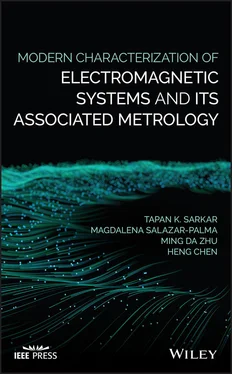1 ...7 8 9 11 12 13 ...18 In Chapter 5, the source reconstruction method (SRM) is presented. It is a recent technique developed for antenna diagnostics and for carrying out near‐field (NF) to far‐field (FF) transformation. The SRM is based on the application of the electromagnetic Equivalence Principle, in which one establishes an equivalent current distribution that radiates the same fields as the actual currents induced in the antenna under test (AUT). The knowledge of the equivalent currents allows the determination of the antenna radiating elements, as well as the prediction of the AUT‐radiated fields outside the equivalent currents domain. The unique feature of the novel methodology presented is that it can resolve equivalent currents that are smaller than half a wavelength in size, thus providing super‐resolution. Furthermore, the measurement field samples can be taken at spacing greater than half a wavelength, thus going beyond the classical sampling criteria. These two distinctive features are possible due to the choice of a model‐based parameter estimation methodology where the unknown sources are approximated by a basis in the computational Method of Moment (MoM) context and, secondly, through the use of the analytic free space Green’s function. The latter condition also guarantees the invertibility of the electric field operator and provides a stable solution for the currents even when evanescent waves are present in the measurements. In addition, the use of the singular value decomposition in the solution of the matrix equations provides the user with a quantitative tool to assess the quality and the quantity of the measured data. Alternatively, the use of the iterative conjugate gradient (CG) method in solving the ill‐conditioned matrix equations for the equivalent currents can also be implemented. Two different methods are presented in this section. One that deals with the equivalent magnetic current and the second that deals with the equivalent electric current. If the formulation is sound, then either of the methodologies will provide the same far‐field when using the same near‐field data. Examples are presented to illustrate the applicability and accuracy of the proposed methodology using either of the equivalent currents and applied to experimental data. This methodology is then used for near‐field to near/far‐field transformations for arbitrary near‐field geometry to evaluate the safe distance for commercial antennas.
In Chapter 6, a fast and accurate method is presented for computing far‐field antenna patterns from planar near‐field measurements. The method utilizes near‐field data to determine equivalent magnetic current sources over a fictitious planar surface that encompasses the antenna, and these currents are used to ascertain the far fields. Under certain approximations, the currents should produce the correct far fields in all regions in front of the antenna regardless of the geometry over which the near‐field measurements are made. An electric field integral equation (EFIE) is developed to relate the near fields to the equivalent magnetic currents. Method of moments (MOM) procedure is used to transform the integral equation into a matrix one. The matrix equation is solved using the iterative conjugate gradient method (CGM), and in the case of a rectangular matrix, a least‐squares solution can still be found using this approach for the magnetic currents without explicitly computing the normal form of the equations. Near‐field to far‐field transformation for planar scanning may be efficiently performed under certain conditions by exploiting the block Toeplitz structure of the matrix and using the conjugate gradient method (CGM) and the fast Fourier transform (FFT), thereby drastically reducing computation time and storage requirements. Numerical results are presented for several antenna configurations by extrapolating the far fields using synthetic and experimental near‐field data. It is also illustrated that a single moving probe can be replaced by an array of probes to compute the equivalent magnetic currents on the surface enclosing the AUT in a single snapshot rather than tediously moving a single probe over the antenna under test to measure its near‐fields. It is demonstrated that in this methodology a probe correction even when using an array of dipole probes is not necessary. The accuracy of this methodology is studied as a function of the size of the equivalent surface placed in front of the antenna under test and the error in the estimation of the far‐field along with the possibility of using a rectangular probe array which can efficiently and accurately provide the patterns in the principal planes. This can also be used when amplitude‐only data are collected using an array of probes. Finally, it is shown that the probe correction can be useful when the size of the probes is that of a resonant antenna and it is shown then how to carry it out.
In Chapter 7, two methods for spherical near‐field to far‐field transformation are presented. The first methodology is an exact explicit analytical formulation for transforming near‐field data generated over a spherical surface to the far‐field radiation pattern. The results are validated with experimental data. A computer program involving this method is provided at the end of the chapter. The second method presents the equivalent source formulation through the SRM described earlier so that it can be deployed to the spherical scanning case where one component of the field is missing from the measurements. Again the methodology is validated using other techniques and also with experimental data.
Two deconvolution techniques are presented in Chapter 8to illustrate how the ill‐posed deconvolution problem has been regularized. Depending on the nature of the regularization utilized which is based on the given data one can obtain a reasonably good approximate solution. The two techniques presented here have built in self‐regularizing schemes. This implies that the regularization process, which depends highly on the data, can be automated as the solution procedure continues. The first method is based on solving the ill‐posed deconvolution problem by the iterative conjugate gradient method. The second method uses the method of total least squares implemented through the singular value decomposition (SVD) technique. The methods have been applied to measured data to illustrate the nature of their performance.
Chapter 9discusses the use of the Chebyshev polynomials for approximating functional variations arising in electromagnetics as it has some band‐limited properties not available in other polynomials. Next, the Cauchy method based on Gegenbauer polynomials for antenna near‐field extrapolation and the far‐field estimation is illustrated. Due to various physical limitations, there are often missing gaps in the antenna near‐field measurements. However, the missing data is indispensable if we want to accurately evaluate the complete far‐field pattern by using the near‐field to far‐field transformations. To address this problem, an extrapolation method based on the Cauchy method is proposed to reconstruct the missing part of the antenna near‐field measurements. As the near‐field data in this section are obtained on a spherical measurement surface, the far field of the antenna is calculated by the spherical near‐field to far‐field transformation with the extrapolated data. Some numerical results are given to demonstrate the applicability of the proposed scheme in antenna near‐field extrapolation and far‐field estimation. In addition, the performance of the Gegenbauer polynomials are compared with that of the normal Cauchy method using Polynomial expansion and the Matrix Pencil Method for using simulated missing near‐field data from a parabolic reflector antenna.
Typically, antenna pattern measurements are carried out in an anechoic chamber. However, a good anechoic chamber is very expensive to construct. Previous researches have attempted to compensate for the effects of extraneous fields measured in a non‐anechoic environment to obtain a free space radiation pattern that would be measured in an anechoic chamber. Chapter 10illustrates a deconvolution methodology which allows the antenna measurement under a non‐anechoic test environment and retrieves the free space radiation pattern of an antenna through this measured data; thus allowing for easier and more affordable antenna measurements. This is obtained by modelling the extraneous fields as the system impulse response of the test environment and utilizing a reference antenna to extract the impulse response of the environment which is used to remove the extraneous fields for a desired antenna measured under the same environment and retrieve the ideal pattern. The advantage of this process is that it does not require calculating the time delay to gate out the reflections; therefore, it is independent of the bandwidth of the antenna and the measurement system, and there is no requirement for prior knowledge of the test environment.
Читать дальше












